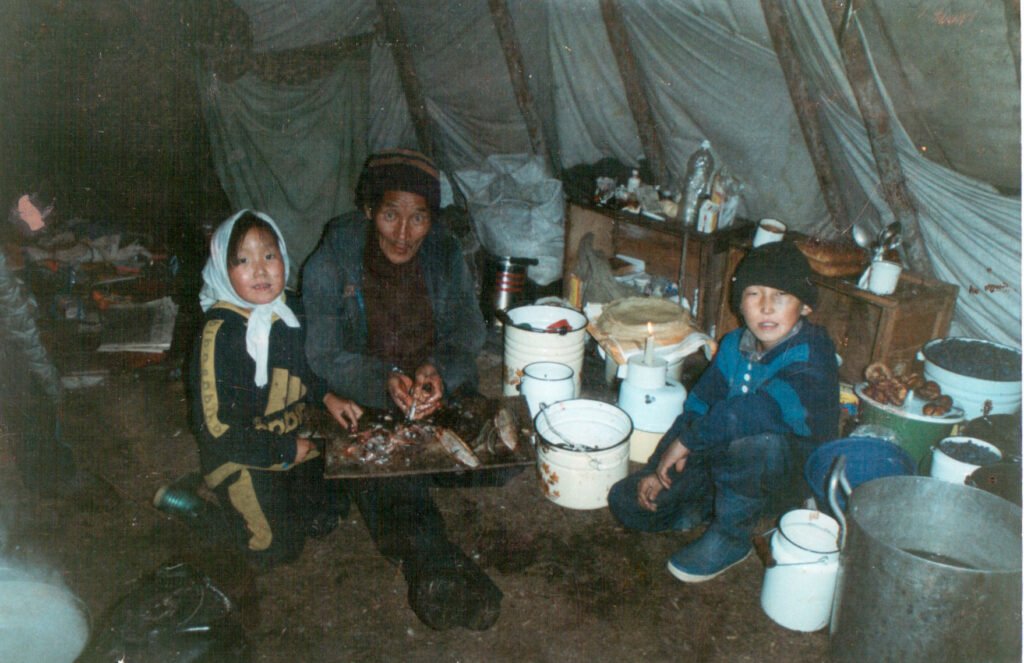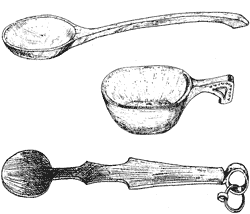
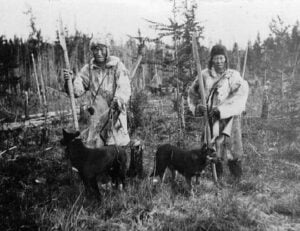
For most groups of Evenks, hunting has historically been the main occupation that determines the entire economic structure and production calendar. Since the invention of the compound alang bow, the traditional way of life of the Tungus peoples has developed on the basis of nomadic elk hunting. The terminology associated with hunting ungulates is common for all Tungus-Manchu peoples, which also indicates hunting as the original occupation of the Tungus. All other forms of farming - horse breeding, reindeer breeding, fishing - were mastered by the Tungus (Evenks) later in the process of historical development.
For most groups of Evenks, the most important hunting objects were large ungulates - elk, wild deer, in a smaller part, red deer and other smaller animals. Elk were hunted all year round, using various hunting methods - skrad, rut (on an ice crust), from a boat, on salt licks, with dogs, as well as with crossbows and loops. Due to the competent use of resources, the population of the main hunting object has always remained stable. Hunting for wild deer has played and continues to play an important role in the economy of the Evenks living in the northwestern regions of Siberia (basins of the Vilyui, Olenek rivers, etc.).
Among other groups of Evenks, hunting for wild deer was not so significant, mainly during periods of migration - in spring and autumn. Some groups of Evenks used the method of hunting with a beckoning deer to hunt wild deer. Hunting for red deer and musk deer was popular among the Evenks in mountainous, rocky areas. To hunt these animals, the Evenks widely used birch bark decoys - pichavun (for musk deer) and orevun (for red deer). Bird hunting was accompanying. The most important bird hunting objects were wood grouse, black grouse, hazel grouse, as well as geese and large ducks.


Fur trade was initially present in the Evenk household, mainly for their own needs - for sewing, decorating clothes, and also insignificantly for trade. The main objects of hunting were squirrels, foxes, etc. With the arrival of the first Russians, fur began to be widely used as a means of exchange and the equivalent of a monetary unit - for paying taxes (yasak). Among fur animals, the sable has acquired the main importance. Sable was usually hunted with the help of a dog at the beginning of winter. Sable hunting remains very important for the modern Evenk family, because in a good year allows you to get that insignificant amount of income for a minimum level of subsistence. The bear was also a meat animal, the hunting of which among the Evenks was associated with an ancient cult and was necessarily accompanied by many ritual and ideological traditions.
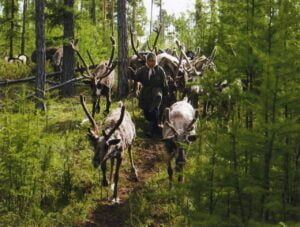

The main weapon of the Evenks was a composite bow and arrows. Also used were a guide spear (double-edged), a short utken spear (piercing and chopping), and knives. Various traps - cherkany, chopping blocks, crossbows, etc. were used to a lesser extent. The Evenki got acquainted with the gun in the 17th century from the moment the first Russians penetrated. For hunting on foot, portable ponyagi shoulder devices were widely used - thin light boards with leather straps. Hunting traditions have been widespread among the Evenks from ancient times to the present. With a successful hunt for a large game, the hunter is obliged to share the prey with members of the clan and neighbors - this custom is called Nimat and is strictly observed at the present time.
Cattle breeding, primarily horse breeding, was developed among the Amur, Trans-Baikal Evenks and groups settled on the territory of Northern China and Mongolia. The Evenki got acquainted with horse breeding earlier than with reindeer breeding. The acquisition of horse breeding took place at the turn of the transition to the Common Era. in the process of reciprocal contacts with the proto-Mongol tribes in the middle and lower reaches of the Amur. On the basis of these contacts, various groups of Evenks were formed - Solons, Dauras, Khamnigans, etc.
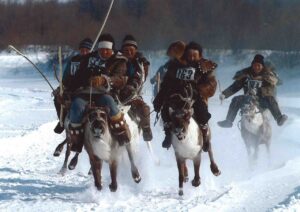
The acquisition of reindeer herding culture took place in the first centuries A.D., much later than the global settlement of the Evenks across Siberia. The Evenk type of reindeer herding historically has its own characteristic features - the small number of herds, its transport function, and also the maximum degree of domestication. The nature of reindeer husbandry was determined by the hunting production and economic cycle. The main care of the deer was carried out in the summer - the most important role in the domestication of the deer was played by the use of smokers, which protected the deer from the midges. In a traditional Evenk family, the main role of caring for reindeer fell on both men and women - women gathered and roamed with a caravan while the man hunted along the route. The deer were also supervised by women in the absence of men. Over time, transport reindeer breeding has firmly become part of the traditional economy of the Evenks and by now it is an inseparable part of the ethnic culture.
Fishing has historically not been the main or important type of economic activity, which is confirmed by the absence of mentions in folklore and in the traditional production calendar. The exceptions are the groups of Evenks who settled in the floodplains of large rivers and were forced to turn to fishing in the face of a decrease in the population of the main hunting objects. Traditionally, the Evenks hunted fish in the summer for a variety of diets. The main objects of fishing were taimen, lenok, grayling and other species living in the rivers of the mountain-taiga zone.
Gathering among the Evenks also had an auxiliary character. With all the richness and diversity of the plant world, the Evenks did not make large reserves and ate plant food, mainly in the summer-autumn period.
All groups of Evenks were engaged in home production for their own needs. Men have long mastered blacksmithing, made utensils, weapons (bows, arrows, crossbows, spears, knives), vehicles (skis, boats, sledges, saddles, etc.). Women made skins, sewed clothes, shoes, processed birch bark for dishes, utensils and dwellings.
- Варламов А. Н. Специфика историзма в фольклоре эвенков: дис… д-ра филологич. н. //Российская академия Наук: Сибирское отделение: Институт Гуманитарных исследований и проблем малочисленных народов Севера. — Якутск: 2011. — 430 с.
- Василевич Г.М. Эвенки. Историко–этнографические очерки (XVIII–начало ХХ в.). – Л.: Наука, 1969. – с. 53.
- Численность лося резко снизилась с проникновением в тайгу русских переселенцев, начиная с XVIII-XIX вв.
- На протяжении 400 лет и наши дни соболь добывается руками охотников-эвенков, но плодами труда пользуются перекупщики, аукционы и зарубежные производители элитной продукции.
- По представлениям эвенков – медведь является тотемным существом и предком эвенков.
- Эвенкийский «М-образный» лук представлял собой сложное и совершенное, для своего времени, устройство с усилением амортизационных свойств за счет костяных накладок.
- В арсенале эвенкийских охотников были несколько типов стрел для охоты на различные объекты охоты.
- Бичурин Н.Я. Собрание сведений о народах, обитавших в Средней Азии в древние времена. Т. 3. – М.-Л.: Изд-во АН СССР, 1953. – с. 47-48.
- Василевич Г.М. Эвенки. Историко–этнографические очерки (XVIII–начало ХХ в.). – Л.: Наука, 1969. – с. 78.
- Мясное оленеводство в среде эвенков встречалось незначительно и в большей степени получило развитие в советское время с возникновением колхозов и совхозов.
- По мнению. Г.М. Василевич лингвистический пласт указывает на приобретение навыков выплавки и обработки металла в эпоху древних тунгусо-монгольских связей.




